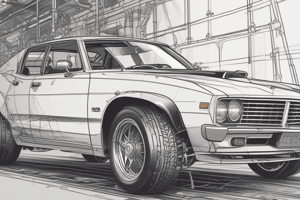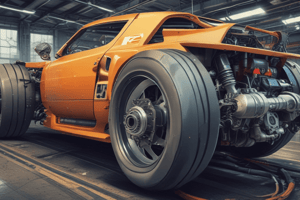Podcast
Questions and Answers
What is the primary purpose of wheel balancing, and how does it affect the overall performance of a vehicle?
What is the primary purpose of wheel balancing, and how does it affect the overall performance of a vehicle?
The primary purpose of wheel balancing is to ensure even weight distribution across the wheel and tire assembly, which affects the vehicle's vibration, fuel efficiency, and tire wear. Proper balancing improves ride quality, reduces vibration, and prolongs tire life.
What are the key differences between radial and bias tires, and how do their constructions impact vehicle handling?
What are the key differences between radial and bias tires, and how do their constructions impact vehicle handling?
Radial tires have cords that run perpendicular to the direction of travel, providing better traction, stability, and fuel efficiency. Bias tires have cords that run at a 32-degree angle, making them more prone to overheating and tread separation. The construction difference affects vehicle handling, with radial tires providing better cornering and braking performance.
What is the significance of tire rotation, and how does it impact tire longevity and vehicle performance?
What is the significance of tire rotation, and how does it impact tire longevity and vehicle performance?
Tire rotation ensures even tread wear, prolongs tire life, and improves vehicle performance by maintaining uniform traction and handling. Regular rotation helps to distribute wear evenly, reducing the likelihood of uneven wear patterns and improving fuel efficiency.
How do different wheel constructions, such as alloy and steel wheels, impact vehicle performance and fuel efficiency?
How do different wheel constructions, such as alloy and steel wheels, impact vehicle performance and fuel efficiency?
What are the primary causes of tire wear, and how can they be mitigated through proper vehicle maintenance and driving practices?
What are the primary causes of tire wear, and how can they be mitigated through proper vehicle maintenance and driving practices?
Flashcards are hidden until you start studying





